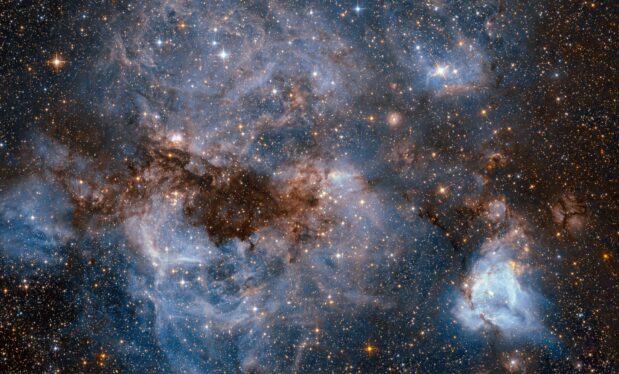2 min read
Hubble Observes a Cosmic Fossil
This NASA/ESA Hubble Space Telescope image features the globular cluster NGC 2005. It’s not an unusual globular cluster in and of itself, but it is a peculiarity when compared to its surroundings. NGC 2005 is located about 750 light-years from the heart of the Large Magellanic Cloud (LMC), which is the Milky Way’s largest satellite galaxy some 162,000 light-years from Earth. Globular clusters are densely-packed groups of stars that can hold tens of thousands or millions of stars. Their density means they are tightly bound by gravity and therefore very stable. This stability contributes to their longevity: globular clusters can be billions of years old, and are often comprised of very old stars. Studying globular clusters in space can be a little like studying fossils on Earth: where fossils give insights into the characteristics of ancient plants and animals, globular clusters illuminate the characteristics of ancient stars.
Current theories of galaxy evolution predict that galaxies merge with one another. Astronomers think the relatively large galaxies we observe in the modern universe formed when smaller galaxies merged. If this is correct, then we would expect to see evidence that the most ancient stars in nearby galaxies originated in different galactic environments. Because globular clusters hold ancient stars, and because of their stability, they are an excellent laboratory to test this hypothesis.
NGC 2005 is such a globular cluster, and its very existence provides evidence that supports the theory of galaxy evolution via mergers. Indeed, what makes NGC 2005 a bit peculiar from its surroundings, is the fact that its stars have a chemical composition that is distinct from the stars around it in the LMC. This suggests that the LMC underwent a merger with another galaxy somewhere in its history. That other galaxy has long-since merged and otherwise dispersed, but NGC 2005 remains behind as an ancient witness to the long-past merger.
Text Credit: European Space Agency (ESA)
Explore More
Media Contact:
Claire Andreoli
NASA’s Goddard Space Flight Center, Greenbelt, MD
claire.andreoli@nasa.gov
https://science.nasa.gov/missions/hubble/hubble-observes-a-cosmic-fossil/






